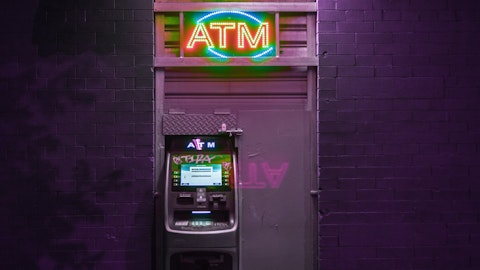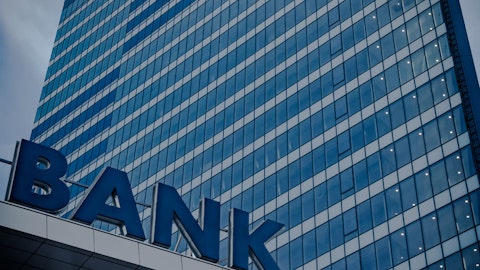We did have that one sale for us that actually was a little bit better than what we had at mark there, but that was one – one big loan. So I wouldn’t say that’s a trend by any stretch right now. But I think we feel pretty good on where we are. As far as the other asset classes, I think we – just with rates higher for longer, just puts more just tougher for some of our – the customers. And multifamily is an area that we are looking at as well. Nothing really is popping out of anything very superior there yet. But we’re just trying to stay ahead of what potentially could happen and kind of be preemptive if we see anything. So we’re just preparing our credit team is very experienced. We’ve been very good with commercial real estate for a long time, and we are on top of where we are.
Ebrahim Poonawala: Okay, thank you.
Operator: The next question comes from Erika Najarian with UBS. Please go ahead.
Erika Najarian: Hi, good morning. I just wanted to clarify sort of the responses to Ebrahim’s question, Daryl. I’m just wondering as you think about the forward curve as we see it, at what point do you expect net interest income to trough based on what we know about the curve and what we know about the various puts and takes for growth and deposit actions.
Daryl Bible: Yes. From a framework perspective, it’s really when the intermediation slows down. And when distribution slows down, I think on the asset side, is performing well and will continue to reprice higher because I think we’re going to have a steeper curve for a longer period of time. And hopefully, that will happen in the next couple of quarters, but it’s really hard to know right now we think it’s slowing but I think we will just see how that plays out. I’ll give you guidance next earnings call on the fourth quarter on that. But conditions could be slowing down with what we’re seeing right now, but one quarter is not a trend. I just want to get a couple of quarters under our belt before we really say net interest margin is going to stabilize.
Erika Najarian: Got it. And as a follow-up to that, your period-end cash balance rose to $30 billion, Daryl, which is awesome dry powder. And as we think about the quarters ahead on one hand, potentially the Fed is peaking, right? And you seem to be rather asset sensitive. On the other, you have all these new rules on liquidity that we don’t have yet as well as treatment of AFS for regional banks. So how should we think about an absence of stronger net loan growth? The puts and takes of what you’re – are you just going to continue to build cash and be a little bit more asset sensitive even though we’re peaking in rates as we figure out what the final rules look like on both capital and liquidity.
Daryl Bible: I think we have the strong position at the Fed that’s intentional for us right now. We want to be really conservative with our cash and liquidity position. Like I said earlier, the economy is – do it okay, but slowing down and maybe hopefully not get into a recession, but we just want to be really careful and cautious from that perspective. So I think it’s an intentional where we’re staying there. will we invest some of that obviously into loans, we would love to do that to support our customers, but we are not widening our credit box whatsoever. We’re going to grow what the market will give us, but we do think there is opportunities to grow relationships and to potentially grow balances in some of our loan categories.
So we will see how that plays out. As far as deploying some of it the cash into the securities portfolio, I would just say that over the next year, you might see us move a little bit to the investment portfolio, but it will be on a gradual basis.
Erika Najarian: Thank you.
Operator: The next question comes from Matt O’Connor with Deutsche Bank. Please go ahead.
Matt O’Connor: Good morning. First, sorry if I missed it, but did you comment on what your reserves are against your office book?
Daryl Bible: We haven’t made that probably, Matt, but it continues to increase where we are right now. So we had an increase in our allowance, we had a little over $50 million. I’d say about half of it went to the CRE portfolio, and half of it went to the C&I portfolio. So I think we were adding it where we think it’s appropriate based upon our models and performance.
Matt O’Connor: Okay. Yes, that would be helpful again over time. I know everybody’s book is a little bit different, but many of your peers are disclosing, so that would be helpful as you think my disclosure is obviously an area of focus. Maybe switching gears, like, as you think about all the capital that you have and liquidity and the balance sheet flexibility, what areas of lending are you leaning into, not just kind of looking at one quarter for the next few quarters. And is it kind of doing more business with existing customers or also trying to grow the customer footprint?
Daryl Bible: I mean this past quarter we had growth in our dealership businesses. As the strike was starting to happen, I think a lot of dealers actually stocked up on used cars, and that actually drove an increase in utilization in that one sector or a little bit earlier than normal there. That will probably continue to play out, I think into the fourth quarter, while would be one. Our large corporate banking, I think has some growth opportunities where we are positioned there. Specifically on fund banking, I think we are growing there nicely. It’s a very conservative portfolio, very short-term oriented, lower risk areas. So, I would say most of the growth that we are seeing is in the C&I space. Those are the highlights right now.
It is very competitive in middle market C&I. We are trying to be competitive there. But right now, the higher interest rates are just putting a lot of our commercial clients to be a little bit more cautious. But when they are willing to borrow, we are trying to help them when that’s – when we are able to do that, so.
Matt O’Connor: Okay. Thank you very much.
Operator: The next question comes from Bill Carcache with Wolfe Research. Please go ahead.
Bill Carcache: Thank you. Good morning. Hey Daryl. I wanted to follow-up on your comments around a higher for longer rate environment being tougher for your customers. As you look across your portfolio, do you have a good handle on the degree to which some of your customers had put on swaps maybe when we were still under CRE [ph] 2 years to 3 years ago, so they haven’t yet felt the pressure of higher rates. Curious about whether the rolling off of those swaps is something you worry about, not really not just in CRE, but really across all loan categories.



